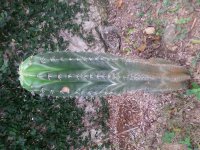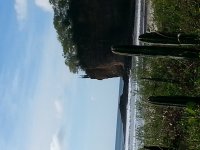-
Members of the previous forum can retrieve their temporary password here, (login and check your PM).
You are using an out of date browser. It may not display this or other websites correctly.
You should upgrade or use an alternative browser.
You should upgrade or use an alternative browser.
Cactus ID in Nicaragua
- Thread starter ۩
- Start date
Migrated topic.
Obviously i am bad at cactus!
goo gle and search thru some of the list to be as confused as i am....
Stenocereus aragonii
Some of the Stenocereus species have uses as purgatives or other medicinal applications.
Many have edible fruit. Some produce anticancer compounds.
Some also contain traces of mescaline but that molecule was not reported from this species.
Many Stenocereus species make great choices as grafting stocks and I'll bet this one would too.
Many have edible fruit. Some produce anticancer compounds.
Some also contain traces of mescaline but that molecule was not reported from this species.
Many Stenocereus species make great choices as grafting stocks and I'll bet this one would too.
hm my guess was pretty close...
stenocereus hystrix- reported to contain mescaline
i was given a sample years ago and it did contain mescaline- but who knows what the sample really was as it was received as dry skins
and the cutting i got also died (not as easy to root as san pedros)
Keeper Trout said:Some of the Stenocereus species have uses as purgatives or other medicinal applications.
Many have edible fruit. Some produce anticancer compounds.
Some also contain traces of mescaline but that molecule was not reported from this species.
Many Stenocereus species make great choices as grafting stocks and I'll bet this one would too.
stenocereus hystrix- reported to contain mescaline
i was given a sample years ago and it did contain mescaline- but who knows what the sample really was as it was received as dry skins
and the cutting i got also died (not as easy to root as san pedros)
Agreed on that hystrix being a bit problematic or at least having some peculiar vague spots.
I presently have serious doubts that any bona fide Stenocereus hystrix contains mescaline. (Or at least if it does this still needs to be proven using LIVE material rather than previously prepared dried flesh where I have to take someone's word what it came from.)
Hystrix also appeared in print as a Ritterocereus but most of the published analytical work on it was as a Lemaireocereus hystrix. It also appeared in some early botanical and ethnomedicinal accounts as the synonym Cereus fimbriatus AKA Stenocereus fimbriatus.
What that modern one in commerce purportedly providing mescaline containing dried flesh really was, how they identified it through the various changes of the species name used for it in their advertizing (they claimed that a botanist identified it but would never diverge more details or say who), why the owner of the company selling it believe it to be a hybrid (this was the last thing he began claiming in our conversations) and what he thought it had hybridized with all remain unanswered for me.
No question that the dried material being sold as coming from this cactus contained mescaline, I just reached the conclusion the dried flesh was probably coming from a different plant and being sold under this name as protective misdirection and camoflage. Similar to the dried peruvianus being shipped out of Peru labeled as floral potpourries, traditional cactus "incense", Opuntia ficus-indica, Cereus variabilis, Cereus species or dried artichoke leaves (all of which have also occurred -- as have no doubt multiple other names.)
Whatever it was, it changed its name I believe three times before sort of settling at Stenocereus hystrix. (I say sort of due to that weird hybrid comment being proposed when questions were raised.) It appears to have first been offered for sale as dried flesh under the name Trichocereus cuzcoensis or at least that was what it was called when it entered my awareness and I started trying to learn what it was. (Amazing such a simple question would prove to be so difficult to answer.)
CactusChemistryBySpecies_2013.pdf contains a summary of what little I could learn on that subject (and a summary of the analysis of bona fide hystrix and assorted other Stenocereus -- mostly still bearing their pre-Stenocereus name assignments) Its readily locateable with google.
Most of that book is a really dry assembly of chemical analysis organized by species in alphabetical order but it now contains a section on cactus species with either reported or purported applications by humans.
I presently have serious doubts that any bona fide Stenocereus hystrix contains mescaline. (Or at least if it does this still needs to be proven using LIVE material rather than previously prepared dried flesh where I have to take someone's word what it came from.)
Hystrix also appeared in print as a Ritterocereus but most of the published analytical work on it was as a Lemaireocereus hystrix. It also appeared in some early botanical and ethnomedicinal accounts as the synonym Cereus fimbriatus AKA Stenocereus fimbriatus.
What that modern one in commerce purportedly providing mescaline containing dried flesh really was, how they identified it through the various changes of the species name used for it in their advertizing (they claimed that a botanist identified it but would never diverge more details or say who), why the owner of the company selling it believe it to be a hybrid (this was the last thing he began claiming in our conversations) and what he thought it had hybridized with all remain unanswered for me.
No question that the dried material being sold as coming from this cactus contained mescaline, I just reached the conclusion the dried flesh was probably coming from a different plant and being sold under this name as protective misdirection and camoflage. Similar to the dried peruvianus being shipped out of Peru labeled as floral potpourries, traditional cactus "incense", Opuntia ficus-indica, Cereus variabilis, Cereus species or dried artichoke leaves (all of which have also occurred -- as have no doubt multiple other names.)
Whatever it was, it changed its name I believe three times before sort of settling at Stenocereus hystrix. (I say sort of due to that weird hybrid comment being proposed when questions were raised.) It appears to have first been offered for sale as dried flesh under the name Trichocereus cuzcoensis or at least that was what it was called when it entered my awareness and I started trying to learn what it was. (Amazing such a simple question would prove to be so difficult to answer.)
CactusChemistryBySpecies_2013.pdf contains a summary of what little I could learn on that subject (and a summary of the analysis of bona fide hystrix and assorted other Stenocereus -- mostly still bearing their pre-Stenocereus name assignments) Its readily locateable with google.
Most of that book is a really dry assembly of chemical analysis organized by species in alphabetical order but it now contains a section on cactus species with either reported or purported applications by humans.
Yes. When this story was still in the active process of unfolding through all of its various twists and turns, as I recall. I think that discussion started right around the time this appeared online being marketed under the name Trichocereus cuzcoensis. I spent almost three years (and a couple of hundred or so dollars) trying unsuccessfully to get live material for analysis before I finally gave up on it. Some of the things we do for love, eh?


